PDF
Aquatic habitat indicators and their application to water quality objectives within the Clean Water Act. EPA-910-R-99-014 Item Info
- Title:
- Aquatic habitat indicators and their application to water quality objectives within the Clean Water Act. EPA-910-R-99-014
- Authors:
- Bauer, Stephen B.; Ralph, Stephen C.
- Contributors:
- Idaho Water Resources Research Institute; University of Idaho
- Date:
- 1999-07
- Description:
- The objective of this paper is to evaluate the application of aquatic habitat variables to water quality objectives under the authority of the Clean Water Act (CWA). The project is limited to freshwater, lotic aquatic habitats in the Pacific Northwest and Alaska with an emphasis on salmonid habitat. Habitat variables were placed into one of the following categories - flow regime, habitat space, channel structure, substrate quality, streambank condition, riparian condition, temperature regime, and habitat access. Candidate habitat variables were evaluated for their relevance to the biotic community, responsiveness to human impacts, applicability to target landscapes, and measurement reliability. The most critical obstacles for use of habitat variables a the regional levels (state specific water quality criteria for Region 10 EPA) are the quantification of biological effect and the unreliability of the measurement system. Inherent variability and unreliable data quality preclude the use of numeric values for habitat variables as compliance indicators in statewide water quality criteria. Rather, habitat variables should be used as diagnostic indicators of beneficial use attainment and pollution control performance, and should be developed and calibrated at local or ecoregional scales as stratified by landscape and stream characteristics. Currently only a few habitat variables meet the evaluation criteria established by the authors for use under CWA authority, specifically large woody debris, pool frequency, and residual pool depth. It is recognized that this limited set of variables will not satisfy the ecological habitat requirements needed to protect cold water biota. Recommendations to increase the applicability of habitat indicators to CWA objectives include an interagency (and international) effort to evaluate landscape classification of aquatic areas, identify and measure reference area condition at ecoregional scales, and develop a systematic approach of habitat indicator quantification. In the interim the authors recommend a re-examination of the narrative water quality standards in EPA Region 10 to provide more specificity in regards to salmonid habitat protection. Water quality standards should also specify the process whereby numeric criteria can be established at the local or ecoregional scale.
- Subjects:
- water quality standards water quality criteria indicators aquatic habitats salmonid
- Source:
- US Environmental Protection Agency, Region 10, Seattle WA
- Identifier:
- IWRRI Number 199902
- Publisher:
- US Environmental Protection Agency, Region 10, Seattle WA
- Contributing Institution:
- University of Idaho
- Type:
- Text
- Format:
- application/pdf
- Cataloger:
- KIT
- Date Digitized:
- 2017-09-26
- Language:
- eng
Source
- Preferred Citation:
- "Aquatic habitat indicators and their application to water quality objectives within the Clean Water Act. EPA-910-R-99-014", Idaho Waters Digital Library, University of Idaho Library Digital Collections, https://www.lib.uidaho.edu/digital/iwdl/items/iwdl-199902.html
Rights
- Rights:
- In copyright, educational use permitted. Educational use includes non-commercial reproduction of text and images in materials for teaching and research purposes. For other contexts beyond fair use, including digital reproduction, please contact the University of Idaho Library Special Collections and Archives Department at libspec@uidaho.edu. The University of Idaho Library is not liable for any violations of the law by users.
- Standardized Rights:
- http://rightsstatements.org/vocab/InC-EDU/1.0/

